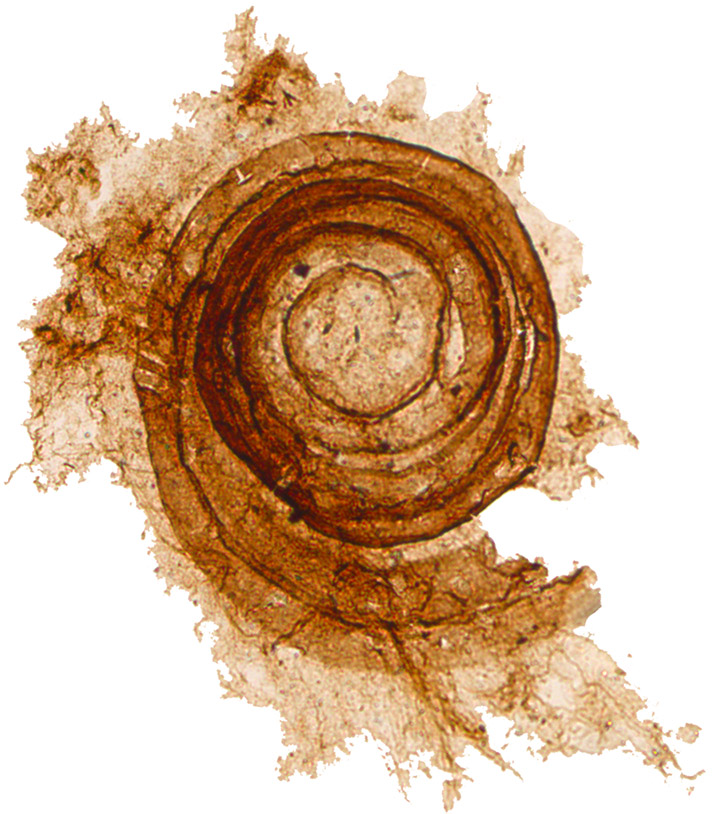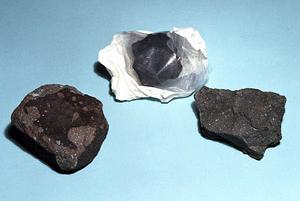|
CI1 Fossils
CI1 fossils refer to alleged morphological evidence of microfossils found in five CI1 carbonaceous chondrite meteorite fall: Alais, Orgueil, Ivuna, Tonk and Revelstoke. The research was published in March 2011 in the fringe ''Journal of Cosmology'' by Richard B. Hoover, an engineer. However, NASA distanced itself from Hoover's claim and his lack of expert peer-reviews. Findings Hoover's team used Environmental (ESEM) and Field Emission Scanning Electron Microscopy ( FESEM) to analyze the meteorite samples, studying internal surfaces. Hoover also produced electron micrographs which he believes resemble the shape of trichomic cyanobacteria and other trichomic prokaryotes such as the filamentous sulfur bacteria. For comparison, Hoover compared the samples to those of terrestrial minerals and biological materials. Hoover concludes from these results that the CI1 fossils are indigenous to the samples. The claims were initially submitted to the ''International Journal of Astrobiolog ... [...More Info...] [...Related Items...] OR: [Wikipedia] [Google] [Baidu] |
Microfossils
A microfossil is a fossil that is generally between 0.001 mm and 1 mm in size, the visual study of which requires the use of light or electron microscopy. A fossil which can be studied with the naked eye or low-powered magnification, such as a hand lens, is referred to as a macrofossil. Microfossils are a common feature of the geological record, from the Precambrian to the Holocene. They are most common in deposits of marine environments, but also occur in brackish water, fresh water and terrestrial sedimentary deposits. While every kingdom of life is represented in the microfossil record, the most abundant forms are protist skeletons or microbial cysts from the Chrysophyta, Pyrrhophyta, Sarcodina, acritarchs and chitinozoans, together with pollen and spores from the vascular plants. Overview A microfossil is a descriptive term applied to fossilized plants and animals whose size is just at or below the level at which the fossil can be analyzed by the naked eye ... [...More Info...] [...Related Items...] OR: [Wikipedia] [Google] [Baidu] |
Cyanobacteria
Cyanobacteria (), also known as Cyanophyta, are a phylum of gram-negative bacteria that obtain energy via photosynthesis. The name ''cyanobacteria'' refers to their color (), which similarly forms the basis of cyanobacteria's common name, blue-green algae, although they are not usually scientifically classified as algae. They appear to have originated in a freshwater or terrestrial environment. Sericytochromatia, the proposed name of the paraphyletic and most basal group, is the ancestor of both the non-photosynthetic group Melainabacteria and the photosynthetic cyanobacteria, also called Oxyphotobacteria. Cyanobacteria use photosynthetic pigments, such as carotenoids, phycobilins, and various forms of chlorophyll, which absorb energy from light. Unlike heterotrophic prokaryotes, cyanobacteria have internal membranes. These are flattened sacs called thylakoids where photosynthesis is performed. Phototrophic eukaryotes such as green plants perform photosynthesis in plast ... [...More Info...] [...Related Items...] OR: [Wikipedia] [Google] [Baidu] |
Astrobiology
Astrobiology, and the related field of exobiology, is an interdisciplinary scientific field that studies the origins, early evolution, distribution, and future of life in the universe. Astrobiology is the multidisciplinary field that investigates the deterministic conditions and contingent events with which life arises, distributes, and evolves in the universe. Astrobiology makes use of molecular biology, biophysics, biochemistry, chemistry, astronomy, physical cosmology, exoplanetology, geology, paleontology, and ichnology to investigate the possibility of life on other worlds and help recognize biospheres that might be different from that on Earth. The origin and early evolution of life is an inseparable part of the discipline of astrobiology. Astrobiology concerns itself with interpretation of existing scientific data, and although speculation is entertained to give context, astrobiology concerns itself primarily with hypotheses that fit firmly into existing scientific ... [...More Info...] [...Related Items...] OR: [Wikipedia] [Google] [Baidu] |
Panspermia
Panspermia () is the hypothesis, first proposed in the 5th century BCE by the Greek philosopher Anaxagoras, that life exists throughout the Universe, distributed by space dust, meteoroids, asteroids, comets, and planetoids, as well as by spacecraft carrying unintended contamination by microorganisms.Forward planetary contamination like '' Tersicoccus phoenicis'', that has shown resistance to methods usually used in spacecraft assembly clean rooms: Panspermia is a fringe theory with little support amongst mainstream scientists. Critics argue that it does not answer the question of the origin of life but merely places it on another celestial body. It is also criticized because it cannot be tested experimentally. Panspermia proposes (for example) that microscopic lifeforms which can survive the effects of space (such as extremophiles) can become trapped in debris ejected into space after collisions between planets and small Solar System bodies that harbor life. Panspermia studies c ... [...More Info...] [...Related Items...] OR: [Wikipedia] [Google] [Baidu] |
Glossary Of Meteoritics
This is a glossary of terms used in meteoritics, the science of meteorites. # * 2 Pallas – an asteroid from the asteroid belt and one of the likely parent bodies of the CR meteorites. * 4 Vesta – second-largest asteroid in the asteroid belt and likely source of the HED meteorites. * 221 Eos – an asteroid from the asteroid belt and one of the likely parent bodies of the CO meteorites. * 289 Nenetta – an asteroid from the asteroid belt and one of the likely parent bodies of the angrites. * 3103 Eger – an asteroid from the asteroid belt and one of the likely parent bodies of the aubrites. * 3819 Robinson – an asteroid from the asteroid belt and one of the likely parent bodies of the angrites. * IA meteorite – an iron meteorite group now part of the IAB group/complex. * IAB meteorite – an iron meteorite and primitive achondrite of the IAB group/complex. * IB meteorite – an iron meteorite group now part of the IAB group/complex. * IC meteorite – an ... [...More Info...] [...Related Items...] OR: [Wikipedia] [Google] [Baidu] |
International Journal Of Astrobiology
The ''International Journal of Astrobiology'' (IJA) is a peer-reviewed scientific journal established in 2002 and published by Cambridge University Press that covers research on the prebiotic chemistry, origin, evolution, distribution, and future of life on Earth and beyond, SETI (Search for extraterrestrial intelligence), societal and educational aspects of astrobiology. It also contains papers in astronomy, space science, planetary science, and biology that have a strong connection to astrobiology. Occasional issues are dedicated to research papers from international astrobiology meetings. The editor-in-chief is Rocco Mancinelli (NASA). According to the ''Journal Citation Reports'', the journal has a 2019 impact factor The impact factor (IF) or journal impact factor (JIF) of an academic journal is a scientometric index calculated by Clarivate that reflects the yearly mean number of citations of articles published in the last two years in a given journal, as i ... of 2.026. ... [...More Info...] [...Related Items...] OR: [Wikipedia] [Google] [Baidu] |
Filamentous Sulfur Bacteria
The word filament, which is descended from Latin ''filum'' meaning " thread", is used in English for a variety of thread-like structures, including: Astronomy * Galaxy filament, the largest known cosmic structures in the universe * Solar filament, a solar prominence seen against the disc of the sun Biology * Myofilament, filaments of myofibrils constructed from proteins * Protein filament, a long chain of protein subunits, such as those found in hair or muscle * Part of a stamen, the male part of a flower * Hypha, a thread-like cell in fungi and Actinobacteria * Filamentation, an elongation of individual bacterial cells Textiles * Fiber, natural or manmade substances significantly longer than they are wide * Yarn (more loosely) * Filament fiber, fiber that comes in a continuous long length Media * ''Filament'' (magazine), a female-oriented erotica magazine * 2002 movie by Jinsei Tsuji * Filament (band), a musical group from Japan * Filament Games, a Wisconsin-based educational ... [...More Info...] [...Related Items...] OR: [Wikipedia] [Google] [Baidu] |
Prokaryotes
A prokaryote () is a single-celled organism that lacks a nucleus and other membrane-bound organelles. The word ''prokaryote'' comes from the Greek πρό (, 'before') and κάρυον (, 'nut' or 'kernel').Campbell, N. "Biology:Concepts & Connections". Pearson Education. San Francisco: 2003. In the two-empire system arising from the work of Édouard Chatton, prokaryotes were classified within the empire Prokaryota. But in the three-domain system, based upon molecular analysis, prokaryotes are divided into two domains: ''Bacteria'' (formerly Eubacteria) and ''Archaea'' (formerly Archaebacteria). Organisms with nuclei are placed in a third domain, Eukaryota. In the study of the origins of life, prokaryotes are thought to have arisen before eukaryotes. Besides the absence of a nucleus, prokaryotes also lack mitochondria, or most of the other membrane-bound organelles that characterize the eukaryotic cell. It was once thought that prokaryotic cellular components within the cytopla ... [...More Info...] [...Related Items...] OR: [Wikipedia] [Google] [Baidu] |
Carbonaceous Chondrite
Carbonaceous chondrites or C chondrites are a class of chondritic meteorites comprising at least 8 known groups and many ungrouped meteorites. They include some of the most primitive known meteorites. The C chondrites represent only a small proportion (4.6%) of meteorite falls. Some famous carbonaceous chondrites are: Allende, Murchison, Orgueil, Ivuna, Murray, Tagish Lake, Sutter's Mill and Winchcombe. General description C chondrites contain a high proportion of carbon (up to 3%), which is in the form of graphite, carbonates and organic compounds, including amino acids. In addition, they contain water and minerals that have been modified by the influence of water. The carbonaceous chondrites were not exposed to higher temperatures, so that they are hardly changed by thermal processes. Some carbonaceous chondrites, such as the Allende meteorite, contain calcium-aluminum-rich inclusions (CAIs). These are compounds that emerged early from the primeval solar nebula, cond ... [...More Info...] [...Related Items...] OR: [Wikipedia] [Google] [Baidu] |
ESEM
The environmental scanning electron microscope (ESEM) is a scanning electron microscope (SEM) that allows for the option of collecting electron micrographs of specimens that are moisture, wet, scanning electron microscope#Sample preparation, uncoated, or both by allowing for a gaseous environment in the specimen chamber. Although there were earlier successes at viewing wet specimens in internal chambers in modified SEMs, the ESEM with its specialized electron detectors (rather than the standard Everhart-Thornley detector) and its differential pumping systems, to allow for the transfer of the electron beam from the high vacuum in the gun area to the high pressure attainable in its specimen chamber, make it a complete and unique instrument designed for the purpose of imaging specimens in their natural state. The instrument was designed originally by Gerasimos Danilatos while working at the University of New South Wales. History Starting with Manfred von Ardenne, early attempts w ... [...More Info...] [...Related Items...] OR: [Wikipedia] [Google] [Baidu] |





